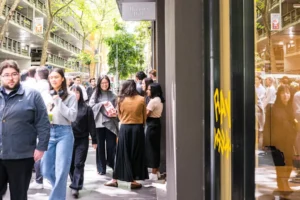
It follows protests outside the property last week, which were livestreamed on social media. Police on Tuesday said there was a “right to lawful protest”, but authorities do not “condone protest action where property is damaged”.
Among politicians criticising the vandalism was Hipkins, who shared a social media post calling the action “totally unacceptable”. He added, “MPs’ homes are not the place to protest”.
That’s brought into question Labour’s position on the legislation and its MPs’ comments.
Labour leader Chris Hipkins said there is a difference between opposing something and outlawing it. Photo / Mark Mitchell
Luxon on Tuesday morning said he couldn’t reconcile that statement with Labour’s decision to oppose legislation in the House to create a new offence of “targeted and disruptive demonstration near residential premises”.
“It’s lovely his sentiments and his words last night, but actually he voted against the bill that actually is designed to stop this stuff from happening,” the Prime Minister said.
“MPs and ministers, we got into public life and we’re fair game. I get that. People should have the right to protest. But actually, our neighbours didn’t, our families didn’t. When you actually get to a point of violence like we’ve seen with signs and broken windows, not great.”
The legislation is intended to provide a “clear statement on the relevance of privacy, and particularly on the importance of use and enjoyment of residential homes, in the context of protests and other demonstrations”.
“Protests and other demonstrations that are targeted at individuals in their residential premises impinge on privacy, disturb use and enjoyment of the home, and can create an environment of fear and intimidation for individuals, their families, and their neighbours. They also have the potential to deter elected officials from taking stands on contentious issues.”
It explicitly outlaws any demonstration near a residential premise that is “directed” at the regular occupant of that premise and when the demonstrator knows or ought to know it will cause “an unreasonable disruption” in relation to that premises or others.
There are a number of factors that go in to determining if a disruption is unreasonable, including the time of day, the duration, the actions of the demonstrators, the level of noise, and the distance between the protest and premises.
Justice Minister Paul Goldsmith, who is in charge of the bill, said the suggestion from Labour that there were technicalities with the legislation that stopped them supporting it was “weasel words”.
‘They chose to vote for protests outside personal houses and now [Hipkins] complains about it.”
Justice Minister Paul Goldsmith has responsibility for the legislation. Photo / Mark Mitchell
But Hipkins, who reiterated his condemnation of the attack, said “free speech matters” and getting the detail of the legislation correct was important.
“MPs’ homes should be safe places. No member of Parliament should have people protesting outside their house.”
However, the Labour leader said the legislation had a “number of flaws in it”.
He said Labour didn’t want to see protest being “stymied based on where it takes place” and “we do want to be very, very careful in having any Government intervention that says you can protest here, but you can’t protest there”.
If the Government was to change the law to remove Labour’s concerns, the party could be open to having a conversation about it.
It was his view that people wanting to protest an MP should come to Parliament or go to an MP’s electorate office, though that should be done with “care” as the offices are “also accessed by many vulnerable people looking for help”.
During debate on the legislation in the House back in August, Labour MPs said there were already provisions to address unreasonable behaviour. Some also made the point that protests are meant to be disruptive.
“The point of political action is to disrupt. It is not to be nice. It’s not to be convenient. Protest is disruptive; that’s what a protest is,” Duncan Webb said.
Ginny Andersen said: “Protest sometimes is noisy, sometimes can be inconvenient, and sometimes can be really hard for those people who are nearby to deal with, but those are the very qualities also that make protests effective.”
Speaking on Tuesday morning, Webb said it was appropriate to protest outside MPs’ homes, though noted it was wrong to damage a house.
He explained the “right to peaceful protest is absolutely fundamental in our democracy”.
When the Herald put to him that Hipkins had said MPs’ homes shouldn’t be the place for protest, Webb responded: “In terms of what I think a reasonable person would do, it wouldn’t be to protest outside someone’s house, but the law shouldn’t interfere with what is decent and reasonable behaviour”.
Andersen was asked about her position on disruptive protest. She kept repeating that protesters who breach the peace or cause damage should be prosecuted.
Other Labour MPs said the party’s opposition was based on “technicalities”.
One of them was Lemauga Lydia Sosene. She also said that while New Zealanders have a right to protest, she believed it was inappropriate to do so at a home.
Rachel Boyack said there were “technicalities in the bill that made it far too complicated to implement and you can’t really legislate for that”.
“It comes down to people being respectful,” she said, noting her opposition to protest outside homes regardless of whether they are owned by a politician or not.
Jamie Ensor is a senior political reporter in the NZ Herald press gallery team based at Parliament. He was previously a TV reporter and digital producer in the Newshub press gallery office. He was a finalist this year for Political Journalist of the Year at the Voyager Media Awards.





